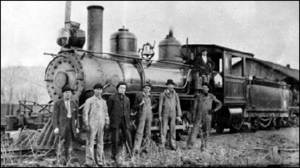East Tennessee and Western North Carolina Railroad
| East Tennessee and Western North Carolina Railroad | |
|---|---|
| Reporting marks | ET&WNC |
| Locale | North Carolina and Tennessee |
| Dates of operation | 1881 – 1950 |
| Track gauge | 3 ft (914 mm) |
| Headquarters | Johnson City, Tennessee |
The East Tennessee and Western North Carolina Railroad (ET&WNC), affectionately called the "Tweetsie" in reference to the sound of its steam whistles, was a primarily narrow gauge railroad established in 1866 for the purpose of the serving the mines at Cranberry, North Carolina.
History
The ET&WNC Transportation Company was chartered by the Tennessee General Assembly on May 24, 1866. Lack of financial backing led to the venture's failure, and the railroad was abandoned in 1874. The Cranberry Iron Company acquired the line between 1876 and 1879, and designated the railroad one it its subsidiaries. The initial 14.1-mile (2.25-kilometer) run through the Appalachian Mountains from Johnson City to Hampton, Tennessee via Elizabethton was completed on August 22, 1881 by Pennsylvania-based financier Ario Pardee, and the technical expertise of Thomas Matson (the noted railway engineer); a line extension to Cranberry opened on July 3, 1882. Soon dubbed by mountain residents as the "Railway with a Heart" as railroad personnel often performed errands for the locals (and even allowed passengers to ride for free during the Great Depression), its tickets were even validated with a heart-shaped punch.

The ET&WNC (sometimes referred to as the "Eat Taters & Wear No Clothes" Railroad) hauled iron ore from the Cranberry mines, pig iron from the local forge, and lumber from the forests of western North Carolina. CIC purchased the Linville River Railway (LRR, known as the "Arbuckle" line) in 1913, a line originally constructed in the 1890s specifically to haul lumber between Cranberry and Saginaw, North Carolina. The LRR line was subsequently extended to Boone, North Carolina; the tracks suffered heavy damage from a 1940 flood, and the line was abandoned following Interstate Commerce Commission approval on March 22, 1941.
The ET&WNC was one of the major rail lines to haul both passengers and freight in the region during World War II, though business declined dramatically after the War. The narrow gauge track from Elizabethton was soon abandoned, though the ET&WNC retained service between Johnson City and the rayon plants of Elizabethton. The tracks in and around Johnson City (where most of the company's industrial customers were located) were dual gauge to allow for interchange with other railroads; the ET&WNC purchased three standard gauge locomotives to switch cars throughout the area. The ET&WNC Railroad Company officially ceased operations on July 13, 1950.
Soon thereafter, Tweetsie Locomotive No. 12 (a 4-6-0 built by the Baldwin Locomotive Works in 1917, and the last of the original 13 coal-fired ET&WNC steam-powered units) was purchased by a group railroad enthusiasts and shipped to Virginia. Movie cowboy Gene Autry later bought the unit, intending to transport it to California for use in his films. After a lengthy restoration, the locomotive returned North Carolina on May 23, 1957 along with a few pieces of the original rolling stock. That summer, the "Tweetsie Railroad" became the state's newest travel attraction and family theme park. The train travels over a scenic 3-mile (4.8 kilometer) loop through the mountains near Blowing Rock, close to the original end-of-the-line station in Boone. The park operates two steam locomotives: in addition to former ET&WNC No. 12, in 1960 the company acquired No. 190 (the Yukon Queen, a type 2-8-2 locomotive) from the State of Alaska and restored it for operation. An authentic ET&WNC wooden coach also sees regular service, and is typically placed at the rear of the train.
The Green Bay Packaging Company of Green Bay, Wisconsin ultimately acquired the railroad properties and reorganized the company as the East Tennessee Railway (ETRY). The standard gauge line continues to operate switching operations in Johnson City for freight arriving via the CSX and Norfolk Southern Railways.
See also
Historic designations
- National Register of Historic Places #NPS–92000147 — East Tennessee & Western North Carolina Railroad Locomotive No. 12
External links
- ET&WNC Railroad Historical Society official website
- ET&WNC: The East Tennessee and Western North Carolina Railroad
- Slim Rails: East Tennessee and Western North Carolina Railroad
- "Tweetsie Comes Home" article in the October, 1957 issue of Ties, the Southern Railway System magazine.
- Tweetsie Railroad History
- Cy Crumley ET&WNC Photo Collection (johnsonsdepot.com)
References
- East Tennessee & Western North Carolina Railroad (ET&WNC) — accessed on November 26, 2005.
- East Tennessee and Western North Carolina Transportation Company Records, 1868–1970 — accessed on November 14, 2005.
- History of Western North Carolina Railroads article by John Preston Arthur (1914) — accessed on November 14, 2005.
